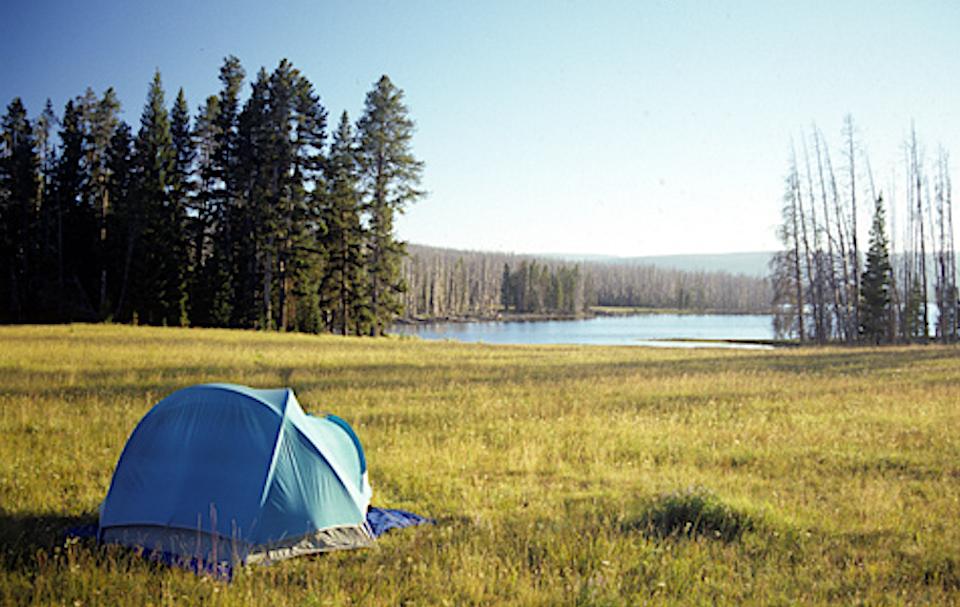
A large majority of backcountry campers in Yellowstone are happy with their experience/Kurt Repanshek file
A study into the experiences of backpackers in Yellowstone National Park came away with the conclusion that almost all had a great experience. Most said they didn't think the park's backcountry was crowded, and they had no problem with the fees they had to pay.
Having done some, but far from enough, backpacking in Yellowstone, I'd have to largely agree. Although 3.7 percent of those surveyed said "they experienced either moderately or extremely" crowded conditions in the backcountry, that no doubt stemmed from the months when they visited the park.
The study, by Ray Darville, Pat Stephens Williams, & Ryan Grisham and published in the latest edition of Yellowstone Science: Vital Signs, Monitoring Yellowstone's Ecosystem Health, notes that back in 2016, when almost 45,000 backpackers headed down one of the park's ~1,000 miles of trails, 77 percent did so during June, July, and August.
The authors conducted their field research in 2016 by contacting backpackers as they registered in Yellowstone's backcountry offices for their trips. Those who agreed to participate in the survey were later emailed the form to complete and return.
The results painted an interesting picture of Yellowstone's backpackers, one which goes to National Park Service concerns that their audience is not highly diverse: "About 64% were male; 95% were white, non-Hispanic; and about 66% were younger than 40 years old. Furthermore, almost 80% had earned at least a bachelor’s degree."
While the average backpack trip in 2016 ran just short of three days, that nevertheless was a longer duration than noted in 1999, the authors said.
Interestingly, at least to me, was that "(S)everal respondents commented that commercially guided groups in the backcountry are diminishing the backcountry experience, including some strong opinions. Almost two-thirds said they believe commercial use was not acceptable."
While some comments on commercial use were positive, most were critical of commercial operations. Backpackers wrote comments such as:
“The National Parks should not exist for the benefit of private enterprise/businesses. The National Parks belong to the American public. This especially pertains to the backcountry, where people go to experience solitude and to ‘get away from’ commercialization and the trappings of civilization;”
and
“Other than the Roosevelt cookout there should not be commercial use because it destroys the integrity of our park. Keep it natural and as simple without crowds as possible. Go to Disneyland if you want commercial.”
The survey also tested the backpackers' backcountry knowledge with a short true-false quiz. The results demonstrated that many backpackers need to bone up on their knowledge.
"Backpackers had the highest mean (99.6% correct) on 'when encountering a bear, one should run away as fast as one can' (false), and the lowest mean (29.7% correct) on the number of times bison can run faster than humans (the correct answer is three times)," the survey showed.
Overall, those surveyed "made a 'C' grade on the survey collectively, despite receiving training prior to being issued their backcountry permits," noted the authors, who recommended that the park staff beef up its backcountry travelers' education, perhaps through a new video that backpackers are required to watch before getting their permits.
"... many backpackers need more education, especially concerning wildlife. While knowledge does not prevent all problems in the backcountry, increased knowledge should lead to better trip experiences and reduce the likelihood of problems," they wrote.
The respondents were largely approving of the fees they were charged. Under the park's fee structure, "backpackers who make advanced reservations are charged a $25 non-refundable fee, and once they arrive in the park they are charged a $3 per person per night fee 'to help support the backcountry through improvement of campsites, trail maintenance, and other management activities.'"
But there were exceptions.
"Comments were overwhelmingly supportive, such as: 'It's a gift to spend time in the park. Worth it!!!' and 'What you're doing with the money is positive. You could have an option for people who don't have the money to pay, some volunteer options perhaps, or a scholarship fund,' and 'If additional revenue is needed to maintain or increase the quality of the experience, I support it,' and 'Fine to charge a little bit. Having good trails is not free. But it needs to be cheap so anybody can go.' There were negative comments too, such as 'Let nature be free. It's where we all belong. Most of us are broke - it's 2016,'" the authors noted.
In their conclusions, the authors said, "(G)iven the near universal support for the new backcountry fee and considering the current and anticipated future levels of federal government support for parks, park managers should consider other opportunities to allow visitors to support their parks. Yellowstone backpackers might support modest additional fees. In addition, in an effort to increase communication between backcountry staff and backpackers, we recommend backcountry staff inform all visitors how the fee money is being spent; this is good public relations and may encourage further donations once visitors see their money at work."
While Yellowstone's backcountry use has remained relatively level this century -- there were 39,297 backpackers in 2000, and 41,978 in 2018 -- numbers were up and down across the National Park System, as the following table illustrates. Data came from the Park Service's Visitor Use Statistics website.
Without contacting each of the following parks, it's difficult to explain the swings, some quite significant. For instance, backpacking in Kings Canyon fell from 59,701 in 2000 to 23,876 in 2018, Isle Royale's backcountry traffic plummeted from 40,157 to 24,758, and Sequoia's from 65,865 to 37,881.
If you've backpacked in any of these parks, please share your experiences below.



Comments
Great Information!